Even though it is played on ice, hockey is a fiery sport, with numerous fans across the globe. With professional leagues like NHL and AHL, hockey games offer major thrilling moments for numerous hockey enthusiasts. Hockey is also a great betting option at many online sportsbooks that cover the biggest hockey events and offer their patrons a great interactive betting experience.
While hockey enjoys fans from different parts of the world, its biggest fanbase is in North America. This is why the repeal of PASPA in 2018 was also a huge win for hockey betting fans in the US. As sports betting is now legal in a number of states, more hockey fans have the chance to raise their excitement levels and bet on their favorite hockey teams and players. What is more, as Las Vegas, the gambling hub of the US, got its own hockey team in 2017, hockey betting has significantly grown in popularity.
If you are interested in making hockey bets, we suggest you continue reading our detailed guide. We will make sure to cover all important elements of the sport itself and the different hockey betting options you may find online. Whether you are a complete newbie or you have some experience in sports betting, we will make sure to let you in on the ins and outs of hockey betting.
More Articles From This Guide
Betting on NHL
Dubbed one of the Big Four in America, the NHL attracts fans not only from Canada and the US, but enjoys exceptional popularity around the world as well.NHL Betting Odds and Lines Explained
The NHL is a league that has been an excellent source of entertainment for over a century.Most Popular NHL Bets
The NHL is the largest ice hockey league in the world, and placing bets on NHL events is a favorite for numerous across the globe.NHL Moneyline Bets
Nowadays, it seems sports bettors are pretty much spoilt for choice no matter which sport they wager on.NHL Over Under Betting
The NHL is a league with quite a rich history in the USA and Canada.NHL Puck Line Betting
Although the term puck line might sound alien at first, there is nothing to worry about, since this bet type is actually one of the most tried-and-true wagers in NHL betting.NHL Prop Bets
Proposition bets, also known as specials, are some of the most entertaining bets offered at online sportsbooks.NHL Live/In-play Betting
Live betting is a practice that took off quickly after it was first implemented.NHL Betitng Systems
The NHL league enjoys a prominent presence at both US-friendly bookies and sportsbooks that cater to international punters.NHL Arbitrage Betting
Wagering on the NHL can be a costly pastime.NHL Matched Betting
Although wagering on the NHL is nothing but a hobby for most punters, it is not the same for absolutely everyone.NHL Early Cash Out
It is undeniable that sportsbooks, especially the ones that operate online, are constantly evolving.NHL Parlay Betting
There is no shortage of variety when it comes to the choice of bets you could go for if you wish to wager on NHL matches.NHL Value Betting
Wagering on sports is, for the most part, not known to be a profitable pastime for NHL bettors.
Hockey Rules Explained
Before you start your hockey betting journey, you should make sure you are up on all the moves and general rules in hockey. Knowing the game will help you significantly in establishing the right strategy for making successful hockey wagers. Below, you can find anything from the layout of the hockey rink to the rules that players should follow. That will enable bettors to have a better understanding of the game and the way they can make higher-valued stakes.
Hockey Rink
If you take a look at the layout of the hockey rink, you will notice circles and lines with different colors. The rules of the game are linked to this layout and it is very important to be well aware of what every line and circle of the rink indicates.
- Center Ice/Face-Off Circle – As the name suggests, center ice is the circle in the middle of the rink. This is the area where the puck is dropped by the referee and signifies the start of every period. The puck is dropped in the face-off circle at the beginning of the game as well as after a goal has been scored. When the referee drops the puck, just a single player from each team can be in the center ice area. Once the puck touches the ice, other players from both teams can enter the center ice circle to help their teammates take control over the puck.
- Neutral Zone – On each side of the center ice circle, there are blue lines, indicating the neutral zone. The space that is between those two blue lines represents the defensive area of each of the two teams. There are also four dots in the neutral zone, indicating the spots for the linesmen to drop the puck to resume the game after it has been stopped.
- Blue Line – This is a very important element of the hockey rink’s layout. In addition to outlining the neutral zone, the blue lines on each side of the rink indicate the area between the neutral zone and the defensive zone of each team.
- Face-Off Circles in the Offensive and Defensive Zones – These are two circles in each team’s offensive/defensive zones, indicating the areas where a linesman can restart the game by dropping the puck. There are a total of four face-off circles, with two located in each team’s offensive and defensive zones. It may be obvious, but we will note that the defensive zone of one team marks the offensive zone of the opponents.
- Slot – This is the area right in front of the goaltender, located between the two face-off circles in the defensive zone of each team. The slot area that is the closest to the blue line and furthest from the goal is called the “high slot”.
- Goal Line – The goal line is a red line that spreads across the width of the rink, right at the area where the goal/net sits in the two teams’ respective zones.
- Trapezoid – This is the area that is located right behind the goal. The goaltender is allowed to touch the puck when he is in the trapezoid zone.
- Goal and Crease – The goal is located right at the center of every goal line, located at the team’s defensive zone. Some people also refer to the goal as a net. The area that is painted in blue and is right inf front of the goals is called a crease
Non-Penalty Stoppages in Hockey
When it comes to the basic rules in hockey, it is easy to understand when a game can be stopped without calling any penalty. One of the rules that can cause the stoppage of the play is known as icing. Whenever a player on the red center ice line moves the puck into the offensive zone and it passes the goal line without being touched by any player, this is called icing. In most cases, such as in games in the international, collegiate, and amateur leagues, the game is stopped immediately, meaning there is no need for the defense to touch the puck. Meanwhile, in NHL games, the play stops only when the puck is touched by the defense team.
Games that require the iced puck to be touched by the defense to stop the play allow the offense team to get to the puck first. If the iced puck is touched by the offense, the team that made the icing move in the first place, the play continues instead of being stopped.
If the play is stopped due to icing, the puck is dropped in a face-off circle zone in front of the offense team’s goaltender, with players from that team having to stay in the same positions they were in during the icing of the puck. This is an important rule as many hockey teams go for that move to get the puck away from their zones and manage to bring new players on the rink at the same time.
Another non-penalty stoppage method is known as offside. A hockey play is offside when a player from the offense does not control the puck while he is in the offensive zone but another player from the offense gets the puck to the offensive area of the rink. The play is offside until the puck or all offense players leave the offensive side of the rink.
Other non-penalty moves include hand passes, a puck over the glass, a puck hit with a high stick (above a player’s shoulder), and a puck kicked in the net with feet.
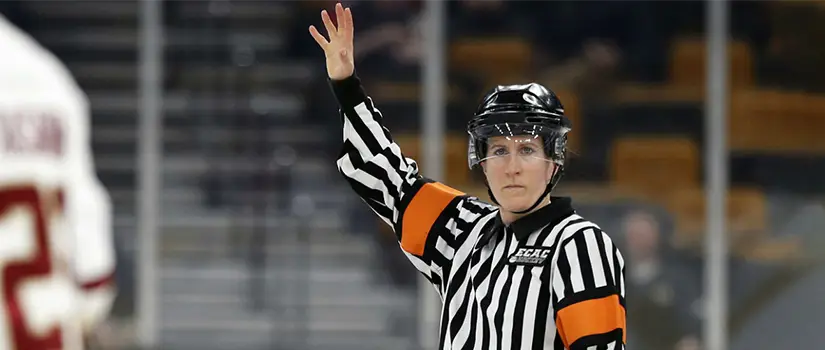
Minor Penalties in Hockey
Penalty stoppages are called when a player makes personal offenses against other hockey players in the game. To call a penalty, the referee raises a hand over his head and waits until a player from the offending team stops the play by touching the puck. The wait for that move is known as delayed penalty and it is common for goaltenders to use that time to get extra offensive players on the rink to score a goal. Offending players receive a penalty and are forced to sit in the penalty box for a certain amount of time.
Minor penalties may be shorter in time, allowing offending players to return to the play earlier. Such penalties include high sticking, tripping, boarding, interference, delay of game, diving, too many players on the rink, cross checking, slashing, holding the stick, hooking, holding/grabbing another player, and roughing. Most minor penalties are unintentional and are called when a player somehow interferes with an opponent either by touching him above the shoulder with his stick, tripping him, being too rough, or any other similar unintentional action.
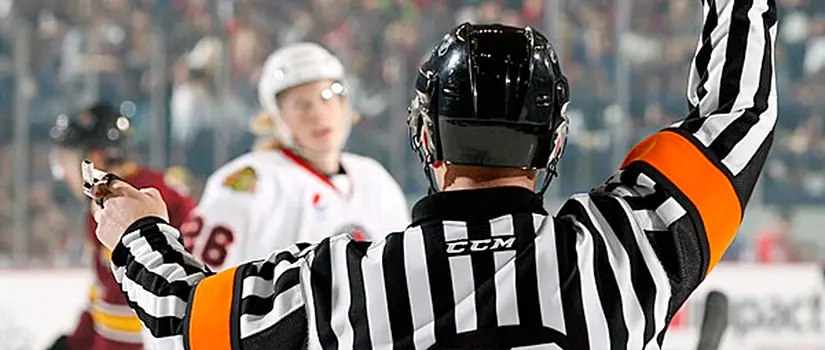
Major Penalties in Hockey
While major penalties are called the same way as minor ones, the time served by the penalized players is longer. Minor penalties can last 2 to 4 minutes tops, while major penalties last 5 minutes. There are several cases of minor penalties being called major penalties if the referee decides that the offending player was intentionally interfering or was too rough with an opponent. Common major penalties include boarding, roughing, fighting, and a game misconduct.
Another difference between minor and major penalties comes with scoring goals. If a penalized player serves a two-minute minor penalty but his team gets scored on, the penalty is over and the player can return to the game. This is not possible when a player is serving a major penalty time as he will stay in the penalty box until the 5-minute penalty time is up.
Penalty Shot
In the game of hockey, the referee can decide to refrain from giving the offensive player a two-minute penalty and award a penalty shot instead. This can be done when a player is grabbed, tripped, or hooked from behind but the referee determines that the offensive player would have made it to the goal area to attempt to score a goal.
When a penalty shot is awarded by the referee, the puck is placed at the center of the rink, with the offensive player given a certain time to get the puck to the offensive zone and try to score a goal. If the rebound is available, the offensive player is not allowed to shoot it. Once the penalty shot is taken, the play is resumed, with the clock also restarting with the following face-off.
Understanding Hockey Odds
To be able to make successful hockey bets, you will first need to understand odds. This will allow you to easily pick betlines and determine the potential return for making successful bets on hockey. There are several typical betlines you will come across while you bet on hockey games. These include moneyline, puck line, and totals (Over/Under).
Moneyline
Moneyline is the most straightforward bet you can make on a hockey game and it is a suitable betting option for less experienced punters. The reason why this is an easy bet to make is the fact that you will simply need to pick the winner of the game. If you head to your preferred sportsbook and select an upcoming hockey match, you will notice that there will be moneylines for both teams. The moneylines express the potential of each team winning the game.
In most cases, sportsbooks use the American odds format to express moneylines. The hockey team that is favored to end up victorious will have its odds expressed in a negative digit. Meanwhile, the other team is selected as the underdog, having a positive value before its moneyline odds.
Let us take as an example a hockey game between team A and team B. If team A is selected as the favored winner, its moneyline odds may look something like -160. Meanwhile, in this case, team B is the underdog and may have odds similar to +130. This indicates that a stake of $100 on team B will award a win of $150. Meanwhile, a $160 stake on the favored team will bring you a $100 win if the bet is successful.
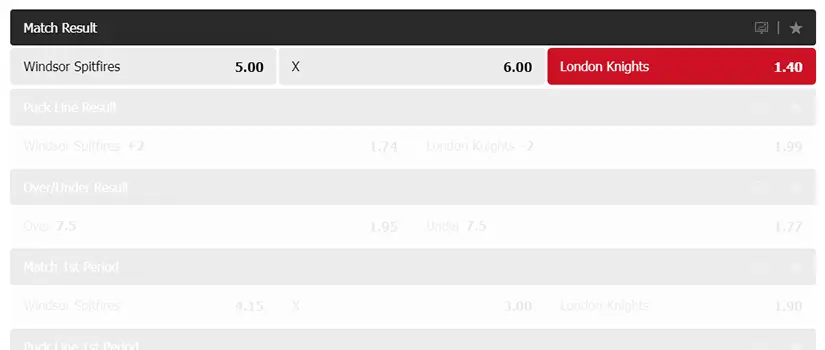
Puck Line
Another common type of bet you can make on hockey games is known as a puck line. This is hockey’s version of point spread betting that is common for other sports. It designates a specific number of goals as a handicap between the hockey teams that are competing against each other. Since hockey is mainly a game with low scoring and often the competition between the two teams is extremely intense, the typical puck line is designating a score gap of 1.5 goals. For this type of hockey bet, the favored team will have odds of -1.5, while the underdog’s odds will be represented as +1.5.
The puck line bet on the favored team is won if it ends up winning the game by at least two goals. Meanwhile, the underdog’s puck line wager will bring punters wins if the designated team enjoys an outright win or loses by less than two goals. You will notice that sportsbooks will also apply a set of odds to the puck line of each of the competing teams. This is the so-called vig or juice, indicating the value of the bet that is placed.
We can take for example a game between team A and team B, with team A being the favored winner with a puck line of -1.5 and odds of -160 and team B being the underdog with a puck line of +1.5 and odds of +130. This indicates that a $100 bet on team B’s puck line will award a $130 if that team wins outright or loses by just one point. Meanwhile, if the favored team A beats its opponent by at least two goals, a $160 stake on the puck line will bring you a $100 win.
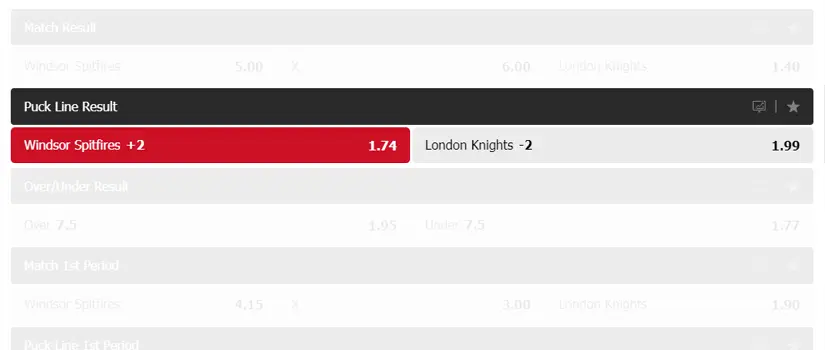
Over/Under
Over/Under, also referred to as totals, is another common type of wager you can make when betting on hockey games. Just like with other sports, hockey totals determine a specific number of goals for the game, with punters predicting whether the final score will go under or over the foretold total of goals.
As mentioned above, hockey is a low-scoring sport, which is why totals for hockey games may often range between 5 and 6.5 goals. Unlike other sports, such as football and basketball, hockey Over/Under bets rarely move that much. This is why it is better to pay attention to the odds attached to the Over/Under betlines, as they will express the vig/juice.
We can take a look at a hockey game with an Over/Under total of 5.5 for a game between team A and team B. The sportsbook may decide to give the Over line a slight advantage and attach odds of -120, while the odds for the Under value may look anything similar to +110. This would mean that making a $120 wager on Over will win you $100 if the game ends with a total score of six or more goals. Meanwhile, betting $100 on Under will grant $110 to bettors if the total score of the game is below 5 goals.
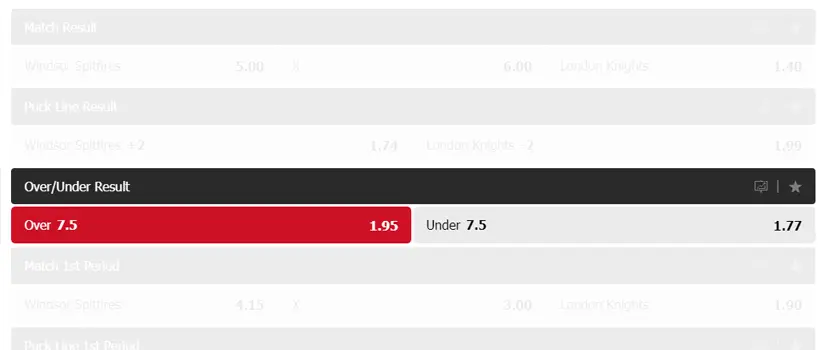
Alternative Bets On Hockey Games
In addition to the standard bet types that can be usually made on hockey games, there are other options that you can make use of. Bets like parlays, futures, derivatives, and many more can make one’s hockey betting experience more riveting and fruitful. Below, we have provided several advanced bets you can make when you want to add some extra spice to your hockey betting.
Parlays
Parlays offer punters very exciting betting adventures, with bets usually requiring making riskier decisions. The essence of making parlay bets is to place several hockey wagers at once. This will ensure significantly larger payouts for lucky bettors as they can combine the odds on a number of bets. The tricky part about winning a parlay bet is that all selections included in the parlay must be successful to win the parlay wager. Even if one leg ends up losing, you will not win your parlay bet on hockey.
Futures
Another great betting option you can make at numerous sportsbooks that cover hockey games is Futures. These bets enable punters to place wagers on popular long-running hockey events. Typically, bettors can try to predict the team to win the Stanley Cup or bet on the teams to make the playoffs, win the Presidents’ Trophy, or mark other achievements in hockey. Some sportsbooks also offer futures bets for the best scorer or MVP in a league as well as the final points of teams.
Prop Bets
Prop bets are a fun wagering option bettors can make use of while betting on hockey at different virtual sportsbooks. This type of wager enables punters to place money on unconventional outcomes, different from the winner of the game or the final score of a game. Hockey prop bets are easy to understand, especially once you get the grip of moneyline betting. You will have odds for the possibility of a particular outcome happening. If the sportsbook favors the event happening, this line will have the negative odds value, while the less likely outcome will have the positive odds value. Hockey prop bets may offer the chance of betting on a particular player, individual team, and various events that may happen during a hockey game.
Derivatives
When betting on hockey games, you may also have the chance to make derivative bets. This type of wager allows bettors to place their money on a specific fragment of the hockey game. Derivatives often include totals and moneyline bets on the goals performed during the first period or the leading team after the second period. It is a great option that can add some extra fun to your hockey betting, allowing you to focus on a specific portion of the game, rather than the entire event.
Strategies to Apply When Hockey Betting
One way to make your hockey betting more successful is to follow some tips and tricks that can help you along your journey. During the NHL season, you can have numerous betting options to make use of. If you use the right strategy, you can easily elevate your wagering experience and hopefully make more successful bets. Below, we have provided several tips you can apply to your next hockey betting session and improve the overall outcome of your betting endeavors.
Evaluating Both Hockey Teams
Like with bets on many other sports, successful hockey bets also require properly assessing the strong and weak points of both teams competing in a game. If you know that a team typically shows strong physical performance but is often in the penalty box, facing opponents with a strong attacking strategy may not be in favor of the first team.
Another example of a bad matchup is having a team with a thin blue line facing opponents who are resorting to a deep forward rotation strategy. This may easily tell you which betline to pick when betting on the game-winner.
When you are comparing hockey matchups, you are also advised to pay close attention to starting goaltenders. Since the goalies throughout the game can change, with each one of them showing different skills, it is advised to assess the latest results instead of focusing on stats from the whole season.
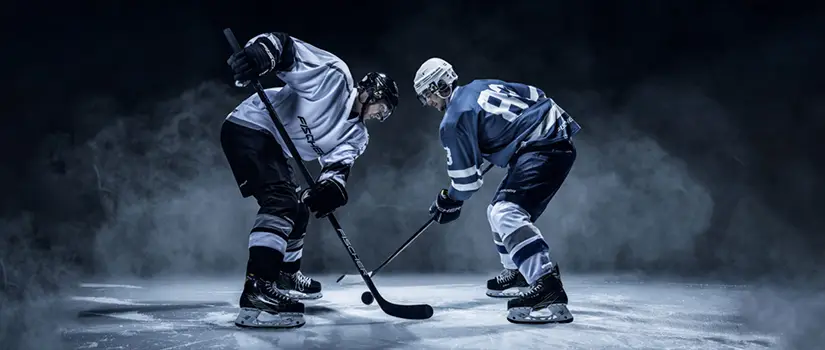
Injuries
One of the most important factors that affect the performance of hockey players is having any recent injuries. Since hockey is a draining sport and players have to perform while being on a very tight schedule, it is common to see players leave the game for either a shorter period or take more extensive breaks.
If a player is replaced by a teammate due to an injury, you must assess how valuable the injured player is for the overall success of the team. The effect of missing a player may be different and it is important to evaluate the potential of winning or losing the game without the participation of the specific player.
Let us assume that the injured player is an offensive-minded defenseman. This is a position that can be very important for some hockey teams and losing such a player may be indicative of lowering the team’s chances of a win. Another example of an injury having a big impact on the game is having to compensate for an injured second-line winger. In such cases, coaches often have to move forward corps from their original positions, affecting the initial scoring lines.
Movements of Lines
The movement of lines is yet another important factor to consider when you are constructing your betting strategy. When you are betting on hockey games, it is important to make sure you are betting on the most profitable odds. Just like it is with other sports, odds on hockey games can constantly change. Factors that contribute to the fluidity of hockey odds include previous results, injuries, and various actions that take place before the match.
You will notice that the odds for a specific hockey game change since the lines are open until the very last minute before the puck is dropped. This is why it is crucial to keep track of line movements before you place your wagers on hockey games. If you manage to get the best value for your hockey predictions, you can enjoy outcomes that will be much more rewarding.
Checking Trends
When you are betting on hockey, it can be extremely beneficial to check trends as they can help you make the right prediction. One thing to keep in mind is that long-standing trends are not always very accurate as players, coaches, and hockey teams change every season. That said, seasonal trends can be very useful when you are making your hockey bets.
As hockey is a game with a rather busy schedule, it is common for the same team to have three or even four games a week. The results of that many games will definitely help you keep a track of trends and make more successful bets on upcoming hockey games.
Playing at Home vs. Playing Away
Another important factor that you can consider when you are making your hockey bets is the venue where the team plays. Playing home and playing away can have a big impact on the performance of a hockey team. If a team is traveling way too often, that can easily tire out players, ultimately affecting the outcomes of upcoming games.
It is also important to check if the team is returning to play after a long break. It is common for hockey teams to experience either a “lookahead” or “letdown” during the season. The former is a situation where you have a hockey team overlooking a weaker competition and putting all of its efforts into an upcoming game against a stronger opponent. Meanwhile, the letdown position is when a team suffers a loss immediately after a major win. These are all factors that one should not ignore as they can help them make more successful hockey bets.
Handicapping Referees
Whenever you are looking for a way to find an edge in hockey odds, you could resort to the method of handicapping referees. If you are a long-time hockey fan, you have probably noticed that each NHL referee or linesman has his unique methods when it comes to decision-making. This is especially true when we talk about calling penalties.
If the referee allows a more physical play, this is a huge advantage for teams that are used to a more aggressive approach, relying on forechecks and harsher play. Meanwhile, some referees prefer a more wide-open hockey play and are quick to call penalties for a more aggressive play. If you can spot the specific monitoring style of a referee, you can easily find an edge in NHL odds.
 Hockey Rules
Hockey Rules